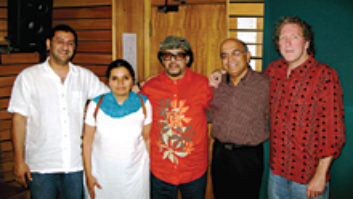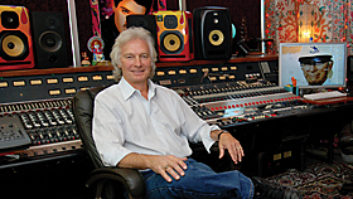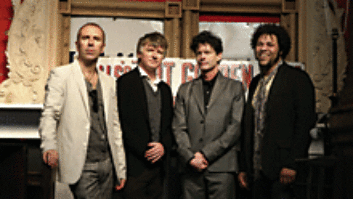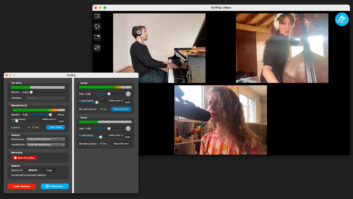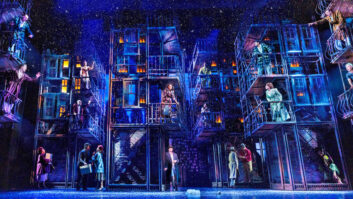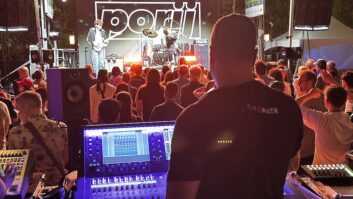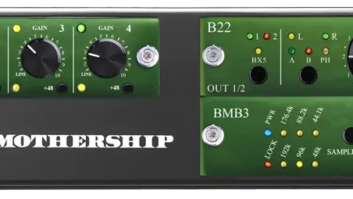In many ways, Miles From India — a two-CD set of Indian musicians and a host of Miles Davis alumni interpreting a number of the jazz great’s works — is a natural. Many of his pieces — particularly from his early electric period — were rhythmically intriguing and open-ended enough that it is easy to imagine Indian percussion fitting in. Plus, on Davis’ Bitches Brew (’70) and On the Corner (’72) sessions, he actually used some Indian musicians on a few tracks, so he clearly had an affinity for those exotic textures.
Even so, Miles From India is full of surprises, as mellifluous Indian vocalists soar above trumpet and electric guitar; tablas and traps combine to create driving rhythms; and sitar and bass clarinet merge in unlikely ways over the course of a dozen wild, diverse and unpredictable tracks, ranging from classic pieces like “So What” and “All Blues” (from Kind of Blue) to “It’s About That Time” (In a Silent Way), “Spanish Key” and “Miles Runs the Voodoo Down” (Bitches Brew) and “Ife” (On the Corner). What’s perhaps most remarkable about the project, though, is that the Indian and American musicians were recorded months apart in their native countries; the performances were then stitched together, much as Davis producer Teo Macero assembled some of Davis’ late-’60s and early ’70s albums.
At the helm of this unusual project was producer Bob Belden, who has shepherded the release of many of Columbia’s “complete recordings” boxes of Davis’ music, the most recent of which was last year’s epic six-CD On the Corner Sessions. Belden conceived the project along with veteran executive producer Yusuf Gandhi (whose specialty has been soundtrack releases), and then was on hand producing as the project moved from Mumbai to New York City between November 2006 and July 2007.
The foundations for each of the tracks were laid in India, with Nepalese jazz keyboardist Louiz Banks working closely with Belden to figure out some basic arrangement notions, tempos (some of which were changed from the original recordings) and ideas for grooves. The Mumbai sessions took place at Famous Studios’ Galactica A, which has a Pro Tools HD3 system, Euphonix System 5-MC console, Dynaudio Acoustics monitoring, a large selection of analog and digital outboard gear, and plug-ins galore. Microphones used on the sessions included B&K 4006s and 4007s, Neumann U67s and 87s, Manley Reference, Schoeps MKs and Collettes, AKG C-414s and C-12s, “and some others from my personal collection,” comments session engineer Farhad Dadyburjor. “These mostly went through Focusrite, Avalon and Digi pre’s and some through the console. Mostly, the instruments were miked in mono; sometimes dual-mono and sometimes stereo. Bob was always admonishing me to keep things simple as we had no idea where the mixes and overdubs might happen at that point.”
Dadyburjor says that all the players were “the cream of Indian musicians,” and that a typical session might involve listening to the original recorded versions a couple of times, “deciding on a tempo and letting it rip. We had a lot of experimentation with different combinations and setups. I pretty much printed everything, and a lot of the rough or guide parts were used in the final. They sometimes played to a click, sometimes jammed along with a basic groove and loops, often tracking three or four guys together.”
Belden adds, “The guys were so easy to work with because what they do — which is kind of different — is they build music there. It’s not like they go into the studio and spontaneously do this. Most of the recordings we know of hardcore Indian music is very patterned and structured and focused, and our stuff is pretty loose — ‘close enough for jazz’ applies. So it was interesting to see them loosen up and be more spontaneous. Generally, the Indian mindset is much more serious.”
From India, the project moved to New York City’s Midtown Sound, where engineer/co-owner Scott Noll presided over a series of sessions featuring various combinations of some of Davis’ bandmates from different periods (“cast” by Belden), including bassists Ron Carter and Michael Henderson; drummers Jimmy Cobb, Ndugu Chancler and Lenny White; alto saxophonist Gary Bartz; tabla player Badal Roy; guitarists Pete Cosey, Mike Stern and John McLaughlin; bass clarinetist Marcus Miller; and keyboardists Chick Corea, Robert Irving III and Adam Holzman, plus the great trumpeter Wallace Roney in the “Davis” slot — improvising over the musical beds that were created in India. Belden and Noll have worked together on various projects for nearly two decades, so it’s a comfortable, symbiotic relationship.
Belden is quick to note that he made a point of not asking any of the distinguished alumni to re-create past triumphs. “But if you say, ‘Jimmy Cobb, here’s an Indian classical vocalist, now what are you going to play? One take — react! Bye!’ you’re going to get something interesting. I think rehearsing kills jazz. We were letting them all be musicians, not re-enacting some historical moment. We weren’t trying to recapture the vibe of the original records in any way. No one wanted to do that. What would be the point of that?”
Adds engineer Noll, “Bob wanted them to respond to something they’d never heard before. These guys knew the tunes, of course, but they were hearing it in a new light. I mean, ‘All Blues’ on sitar? It was a blast.”
Midtown Sound has three live rooms (the largest is 18×22 feet), a giant iso booth and an office that doubles as a recording space. “It’s all sliding-glass doors and huge windows, so when the curtains are open it’s like they’re all in the same room together,” Noll describes. “I do a lot of jazz, so I need to be able to do drums, acoustic grand piano and acoustic bass live.
“The stuff from India was very close-miked,” Noll continues. “I had assumed that everyone played on a giant Bollywood soundstage with everyone playing together, but when I saw the photos, I saw that was not the case — it wasn’t a big room and a lot of it was overdubs. We did a lot of that, as well. Other than the two rhythm section days, there was a day with Mike Stern and a couple with Wallace. And we did some by ISDN from other cities.” John McLaughlin’s title song arrived as a finished master.
Belden comments, “Wallace Roney was stunned I got the horn to sound the way it does. I said, ‘I’ve worked on all these Miles records with great engineers at Sony — they told me everything’; it was like graduate school.” Noll adds, “Bob really wanted that classic, dark Miles tone — a lot was in his playing, but EQ is a tool, too. Trumpet is a very bright instrument, and a lot of that high end — especially if you don’t want it [to sound] piercing — isn’t terribly necessary, so we rolled off a bit of that and then added delay and reverb to put him in the mix. There’s very little compression anywhere on the record. I tried not to disturb their dynamics.” All the reverbs Noll used were plug-ins, including Altiverb (his favorite) and Waves Renaissance Reverb and TrueVerb. (For Roney’s basic horn sound, Noll used an 87 through an Avalon 737 preamp.)
According to Belden, “Reverb is orchestration, compression is orchestration, stereo imaging is orchestration to some degree. I also looked at this as a chance to go into human orchestration. I could put in people who played a certain way that I thought could get a certain reaction. Then I could put another player on top of that and get a reaction. And I could then manipulate it all in the digital realm to take Teo Macero’s idea one step further. I talked to Teo a lot about what I was doing. I had a linear conception in mind and from that it was building everything horizontally to create this labyrinth of sound.”
The amount of editing and manipulation varied from song to song, even section to section. The mix was done entirely “in the box.” Belden says, “[The tune] ‘Jean Pierre’ is ridiculous because I had a drummer play to a click-track in Mumbai, with a flute player and some percussionists, and then I took it to the States and I had [drummer] Vince Wilburn play to the click-track without hearing the other drummer. Robert Irving heard the Indian drummer, Adam Holzman heard Vince, and then I put it all together and it matched. We had to take out some of the flams of the bass drums, but once you’re in that digital realm you can do slight-of-hand. I would take a flute solo from one spot and put it in another spot if I wanted to create a bridge. You can also edit people out, so I would have them overplay and you create a counterpoint where someone would react to somebody, but then you don’t necessarily keep both parts of the interplay. I thought in the tradition of Miles and Teo, you don’t tell anybody anything. And in the end, nobody remembered what they played on, which is good because then they don’t know what’s missing. But also I know these cats as people and they trust me.
“The goal is to make the end result sound like a record, which again was in the spirit of Teo’s work. What he was really saying in his post-1970 work was that we’re in another realm of composing now and the studio is just another instrument. The engineer is just like a bassoon player, the tape machine is part of the band. Now, so is Pro Tools.”
